|
By Rev. Alexander
Sutherland, D.D.
IT is often said that
the Church of Christ is essentially missionary. The saying is trite but
true. The great purpose for which the Church is organized is to “preach
the Gospel to every creature,” and its mission is fulfilled only in so
far as this is done. But, as commonly used, the saying is the
recognition of a principle rather than the statement of a fact. It is
clearly perceived that the Church ought to be intensely missionary in
spirit and practice, and this view is often pressed as an argument to
quicken flagging zeal and to revive, if possible, the apostolic spirit
in the Church of to-day. Compared with apostolic times, missionary zeal
and enterprise is yet below high-water mark ; but compared with the
state of affairs one hundred years ago, it cannot be said that the
former times were better than these. Within the century—indeed, within
the last two or three decades—there has bpen a marvellous revival of the
missionary spirit. The sleep of the Church has been broken. Her dormant
energies have been aroused. An aggressive policy has been declared.
Responsibility, even to the measure of a world-wide evangelism, is
freely acknowledged, and the disposition to consecrate men and money on
the altar of missionary sacrifice grows apace. All this gives token of a
coming day in the not distant future when it may be affirmed without
qualification that the Church—in fact as well as in profession—is
essentially missionary.
It may be claimed,
without boasting or exaggeration, that Methodism has not only
contributed somewhat to the revival of the missionary spirit, but has
been, under God, a chief factor in promoting it. The place of her
nativity was hard by the missionary altar, and a spirit. of intense
evangelism gave the first impluse to her work. Born anew amid the
fervours of a second Pentecost, her first preachers were men baptized
with the tongues of flame, symbol of a comprehensive evangelism that
found expression in the motto of her human leader, “ The World is my
Parish.” In the spirit of that motto Methodism has lived and laboured,
and after the lapse of more than a hundred years the primitive impulse
is still unspent. Wherever the Banner of the Cross is unfurled,
Methodist missionaries are found in the van of the advancing hosts, and
the battle cry of the legions is “The World for Christ.”
The beginnings of
Methodism in Canada reveal the same providential features that marked
its rise in other lands. Here, as elsewhere, it was the child of
Providence. No elaborate plans were formulated in advance. No
forecastings of human wisdom marked out the lines of development. But
men who had felt the constraining power of the love of Christ, and to
whom the injunction to disciple all nations came with the force of a
divine mandate, went forth at the call of God, exhorting men everywhere
to repent and believe the Gospel. Out of that flame of missionary zeal
sprang the Methodist Church of this country; and if the missionary cause
to-day is dear to the hearts of her people, it is but the legitimate
outcome of the circumstances in which she had her birth. Methodism is a
missionary Church, or she is nothing. To lose her missionary spirit is
to be recreant to the great purpose for which God raised her up. Nor can
she give to missions a secondary place in her system of operations
without being false to her traditions and to her heaven-appointed work.
While Methodism in
Canada was, from the very first, missionary in spirit and aims, what may
be called organized missionary effort did not begin till 1824. In that
year a Missionary Society was formed. It was a bold movement, such as
could have been inaugurated only by heaven-inspired men. Upper Canada
(at that time ecclesiastically distinct from Lower Canada) was just
beginning to emerge from its wilderness condition. Settlements were few
and, for the most part, wide asunder. Population was sparse, and the
people were poor. Moreover, Methodism had not yet emerged from the
position of a despised sect, and prejudice was increased by the fact
that it was under foreign jurisdiction. Such a combination of
unfavourable circumstances might well have daunted ordinary men, and led
to a postponement of any effort to organize for aggressive missionary
work. “But there were giants in the earth in those days,” whose faith
and courage were equal to every emergency ; men who could read history
in the germ, and forecast results when “ the wilderness and the solitary
place” should become “glad,” and “the desert” should “ rejoice, and
blossom as the rose.” As yet it was early spring-time, and sowing had
only just begun; but from freshly-opened furrows and scattered seed
those men were able to foretell both the kind and the measure of the
harvest when falling showers and shining suns should ripen and mature
the grain. In that faith they planned and ‘ laboured. They did not
despise the day of small things, but with faith in the “ incorruptible
seed,” they planted and watered, leaving it to God to give the increase.
In this, as in other cases, wisdom was justified of her children. When
the Missionary Society was organized, in 1824, two or three men were
trying to reach some of the scattered bands of Indians; the income of
the Society the first year was only about $140, and the field of
operation was confined to what was then known as Upper Canada. To-day
the missionary force represents a little army of more than a thousand
persons (including the wives of missionaries). The income exceeds
$220,000, while the field covers half a continent, and extends into “the
regions beyond.”
The development of the
missionary idea in the Methodist Church in Canada has been influenced by
epochs in her history, marking changes in her ecclesiastical polity. In
1828, the Canadian Societies were severed from the jurisdiction of the
Church in the United States, and formed into an independent branch of
Methodism, with its own conference and government. In 1832 a union was
formed with the English Wesleyan Conference, whereby the field of
operation was extended; but, unfortunately, this movement was followed
by a division in the Church itself, which continued until the great
union movement of 1883 obliterated all lines of separation and reunited
the divided family. Again, in 1840, the union with the English Wesleyans
was broken, and for seven years the two societies waged a rival warfare,
which was by no means favourable to the growth of true missionary
spirit. This breach was healed in 1847, and from that time onward the
missionary work of the Church steadily developed, embracing the Wesleyan
Indian Missions in the
far north, establishing a new mission in British Columbia, and extending
the home work in all directions throughout the old Provinces of Upper
and Lower Canada.
The year 1873 marks a
distinct epoch in the history of missions in connection with Canadian
Methodism. In that year the bold step, as some considered it, was taken
of founding a distinctively foreign mission, and many indications
pointed to Japan as a promising field. The wisdom of the step was
doubted by many, who thought the home work sufficiently extensive to
absorb the energies and liberality of the entire Church. Viewed from the
standpoint of mere human prudence, the objectors were right. The home
missionaries were struggling along with very inadequate stipends; many
Indian tribes were still unreached; the calls from new settlements in
our own country were loud and frequent, and the vast French population
of the Province of Quebec was scarcely touched by Methodist agencies.
Under such circumstances, it is not to be wondered at that some were
inclined to say : “We have here only five barley loaves and two small
fishes, but what are they among so many % ” But there were others who
remembered the lesson of the “ twelve baskets of fragments ” taken up
after five thousand men, besides women and children, had been fed ; and
these said : “ Let us have faith in God; let us bring our little at His
command, and with Christ’s consecrating blessing our little will
multiply until there will be enough to feed the hungry multitude, and
the Church shall be recompensed far beyond the measure of what it gives
away.” And so in faith and prayer the forward movement was inaugurated,
and a mission planted in Japan which, from the very beginning, has
shared largely in blessings from on high. Nor did the home missions
suffer ‘because of this new departure, for the missionary spirit thus
revived in the Church was followed by a corresponding liberality, and
the increased contributions more than sufficed to meet the increased
expenditure.
The next development
affecting the polity and work of the Church occurred in 1874, when the
Wesleyan Methodist Church, the Methodist New Connexion Church, and the
Wesleyan Church of Eastern British America, united in' one body under
the name of The Methodist Church in Canada. This union extended the Home
Missions of the Church by consolidating the forces east and west, thus
covering the whole extent of the Canadian Dominion, and embracing in
addition, Newfoundland and the Bermudas. This arrangement involved the
peaceful separation of the three churches named from the jurisdiction of
the Wesleyan body in England, and the relinquishment, after a few years,
of certain missionary subsidies which they had been in the habit of
receiving from the parent treasuries. The loss of these subsidies and
the increased expenditure in consequence of unavoidable readjustments of
the work, caused temporary embarrassment and the accumulation of a
somewhat serious debt; but an appeal to the Church met with so liberal a
response, that the debt was extinguished without reducing the regular
income, and the work went on as before. It was felt, however, that, for
a time at least, the duty of the Church would lie in the direction of
consolidation rather than expansion, and hence for several years no new
movement was made beyond the prudent enlargement of fields already
occupied.
The missionary spirit
which for years had been growing in the Methodist Church, found a new
outlet in 1880 in the organization of the Woman’s Missionary Society. In
June of that year a number of ladies met in the parlours of the
Centenary Church, Hamilton, at the invitation of the General Missionary
Secretary, when the project was carefully considered and the conclusion
reached to organize forthwith. That afternoon meeting marks the
beginning of what promises to become one of the most potent forces in
connection with the mission work of the Methodist Church. Nor can a
thoughtful observer fail to see how Divine Providence controlled the
time as well as the circumstances. The Union movement, which culminated
in 1883, was first beginning to be discussed. Four distinct Churches
were proposing to unite, but whether it would be possible so to
amalgamate their varied interests as to make of the four one new Church,
was a problem that remained to be solved. In the accomplishment of this
difficult task, the mission work of the Church was a prime factor, for
it served by its magnitude and importance to turn the attention of
ministers and people from old differences and even antagonisms, and to
fix it upon a common object. What the work of the present Society did
for one part of the Church, the woman’s movement did for another. Just
at the right moment Providence gave the signal, and the godly and
devoted women of Methodism in all the uniting Churches joined hands in
an earnest effort to carry the Gospel to the women and children of
heathendom, and in that effort they mightily aided to consolidate the
work at home. The constitution for a Connexional Society was not adopted
till 1881, but in the nine years following, the income has risen from
$2,916.78 in 1881-2, to $25,560.76 in 1889-90. At the present time
seventeen lady missionaries are in the employ of the Society, and
decision has been reached to send pioneers to China in connection with
the onward movement of the parent Society.
It was thought at one
time that the union of 1874 would have included all the Methodist bodies
in Canada, as all were represented at a preliminary meeting held in
Toronto. This expectation was not realized, owing to the retirement of
several of the bodies from subsequent negotiations ; but the discussions
which took place, no less than the beneficial results of the union
itself, created a desire for union on a more extended scale. This desire
was greatly strengthened by the famous Methodist Ecumenical Conference,
which met in London in 1881, and at the next General Conference of the
Methodist Church in Canada distinct proposals were presented, and
negotiations initiated with other Methodist bodies. It is not necessary
in this paper to present a detailed history of the movement. Suffice it
to say that, in 1883, a union embracing the Methodist, Methodist
Episcopal, Primitive Methodist and Bible Christian Churches in Canada,
was consummated, and the impressive spectacle presented of a
consolidated Methodism—one in faith, in discipline and usages—with a
field of home operations extending from Newfoundland to Vancouver, and
from the international boundary to the Arctic circle, 'i he union did
not actually extend the area formerly embraced by the uniting Churches,
but it involved extensive readjustments of the work, increased greatly
the number of workers, and, for a time, necessitated increased
expenditure. The income, however, showed corresponding growth, and
although stipends remained at low-water mark, no retrograde step was
taken.
As at present
organized, the mission work of the Methodist Church embraces five
departments, namely :—Domestic, Indian, French, Chinese and Foregn. All
these are under the supervision of one Board, and are supported by one
fund. Each department, in view of its importance, claims a separate
reference.
I. THE DOMESTIC OR HOME
WORK.
Under this head is
included all Methodist Missions to English-speaking people throughout
the Dominion, in Newfoundland and the Bermudas. From the very inception
of missionary operations, the duty of carrying the Gospel and its
ordinances to the settlers in every part of the country, has been fully
recognized and faithfully performed. Indeed, this was the work to which
the Church set herself at the beginning of the century, before
missionary work, in the more extended sense, had been thought of. At
that time the population was sparse and scattered. Of home comforts
there was little, and of wealth there was none, but the tireless
itinerant, unmoved by any thought of gain or temporal reward, traversed
the wilderness of Ontario and of the Maritime .Provinces, often guided
only by a “blaze” on the trees or by the sound of the woodman’s axe, and
in rough new school-houses, in the cabins of frontier settlers, or
beneath shady trees on some improvised camp-ground, proclaimed the
message of reconciling mercy to guilty men. No wonder that their message
was listened to with eagerness, and often embraced with rapture. Many of
the settlers had, in early life, enjoyed religious privileges in lands
far away, and these welcomed again the glad sound when heard in their
new homes; while others who, under more favourable circumstances, had
turned a deaf ear to the Gospel message, were touched with unwonted
tenderness as they listened to the fervid appeals of some itinerant
preacher amid the forest solitudes. Thus, by night and by day, was , the
seed scattered which, since then, has ripened into a golden harvest. And
if a time shall ever come when a truthful history of the
English-speaking Provinces of the Canadian Dominion shall be written,
the historian, as he recounts and analyzes the various forces that have
contributed to make the inhabitants of these Provinces the most
intelligent, moral, prosperous and happy people beneath the sun, he will
give foremost place to the work of the old saddle-bag itinerants who
traversed the country when it was comparatively a wilderness, educating
the people in that reverence for the Word and worship of God which is
alike the foundation of a pure morality and the safeguard of human
freedom.
When the Missionary
Society was organized, and its income began to grow, the Church was in a
position to carry on its home work more systematically, and to extend
that work far beyond its original limits. The constant changes taking
place in the status of these Home Fields, as they rise from the
condition of dependent missions to that of independent circuits, renders
any comprehensive numerical statement impossible. Suffice it to say,
that at the present time there are 408 Home Missions, with 371
missionaries, and an aggregate membership of 39,724, and on these is
expended about 42 J per cent, of the Society’s income. The outlook for
this department is hopeful and inspiring. The opening up of our
magnificent North-West, with a teeming population in prospect, presents
a grand field for remunerative mission work which the Church will do
well to improve, and she needs no higher aim than to repeat in the New
Territories the salient features of the religious history of Ontario.
II. THE INDIAN WORK.
This department of
mission work has always shared largely in the sympathy of the Church and
of the Mission Board ; and although it has made but little return, in
kind, for the large sums expended, yet in spiritual results the Church
has been amply repaid. In British Columbia, as the direct result of
missionary effort, tribal wars have entirely ceased, heathen villages
have been transformed into Christian communities, and the gross
immoralities of the dance and the “potlatch” have given place to
assemblies for Christian instruction and sacred song. In the North-West
similar results have been achieved, and it has been demonstrated that
the advancement of the native tribes in intelligence, in morality, in
loyalty, in the arts and refinements of civilized life, keeps even step
with the progress of Christian missions. Very significant is the fact
that during the revolt among certain Indians and Half-breeds in the
North-West, notone member or adherent of the Methodist Church among the
Indians was implicated in the disturbances ; and it is now generally
acknowledged that the unswerving loyalty of the Christian
Indians—notably of Chief Pakan and his people at Whitefish
Lake—contributed more than any other circumstance to prevent a general
uprising of the Cree nation. In Ontario, results in recent years have
not been so marked as in British Columbia and the North-West, owing to
the fact that most of the bands are now in a fairly civilized state, and
there is but little in outward circumstances to distinguish the work
from that among the whites. A.n important feature of the Indian work at
the present time is the establishment of Industrial Institutes, where
Indian youth are instructed in various forms of industry suited to their
age and sex. The Institute at Muncey, Ont., has over eighty pupils, and
is in process of enlargement to accommo-, date 120 ; in Manitoba and at
Reed Deer two Institutes are in process of erection ; an Orphanage and
Training-school has been in operation for some time at Morley; and a
Boarding-school at Chilliwhack, and a Girls’ Home at Port Simpson, are
under the control of the Woman’s Missionary Society. Statistics of the
Indian work for 1890 give the following results :—Missions, 47 ;
missionaries, 35 ; native assistants, 17; teachers, 26; interpreters,
13; members, 4,264. The expenditure for the same year amounted to about
23 per cent, of the Society’s income.
III. THE FRENCH WORK.
In the Province of
Quebec there is a French-speaking population of a million and a quarter,
and these, with the exception of a few thousands, are adherents of the
most solid, thoroughly-organized and aggressive type of Romanism to be
found in all the world. The Church is virtually endowed, can collect its
tithes and levy its church-building rates by law. Education is
controlled by the Bishops, and the whole machinery is used to maintain
the use of the French language and inculcate a French national spirit.
Evangelical truth is a thing almost unknown. Such a population in the
heart of the Dominion, under such control, is a standing menace to
representative government and free institutions, and this consideration,
no less than a sincere desire for the spiritual enlightenment of the
people, has led the various Protestant Churches to make some effort to
spread the Gospel among them. So far as Methodist Missions are
concerned, numerical results have been small, and the missions do not
present features as encouraging as are to be found in other departments.
But it should be borne in mind that the difficulties to be surmounted
are greater than in any other field, and that there are causes for the
comparatively small numerical increase which do not exist elsewhere.
Neither in the Domestic, the Indian, or even i he Foreign work do civil
or social disabilities follow a profession of faith in Christ; but in
the Province of Quebec a renunciation of Romanism is the signal for a
series of petty persecutions, and a degree of civil and social
ostracism, which many have not the nerve to endure, and which usually
results in their emigration from the Province. The difficulty of
reaching the people by direct evangelistic effort, led the Missionary
Board to adopt the policy of extending its educational work. In
pursuance of this policy a site was secured in a western suburb of
Montreal, and a building erected capable of accommodating 100 resident
pupils. About seventy pupils are already in attendance, and the future
is bright with promise. The amount expended on the French work,
including the Institute, is only about 3f per cent, of the Society’s
income.
IV. THE CHINESE WORK.
During the past quarter
of a century vast numbers of Chinese have landed on the Pacific Coast of
the American continent, of these not a few have found temporary homes in
British Columbia. At the time when the Rev. William Pollard had charge
of the British Columbia District some attempt was made to reach the
Chinese by establishing a school among them in Victoria, but after a few
years the enterprise was abandoned. In 1884, Mr. John Dillon, a merchant
of Montreal, visited British Columbia on business. His heart was stirred
by the spiritually destitute condition of the Chinese, especially in
Victoria, and he at once wrote to a member of the Board of Missions
inquiring if something could not be done. The matter was considered at
the next Board meeting, and it was decided to open a mission in Victoria
as soon as a suitable agent could be found. In the following spring,
1885, by a remarkable chain of providences, the way was fully opened,
and a mission begun which has since extended to other places in the
Province, and has been fruitful of good results. Commodious mission
buildings have been erected in Victoria and Vancouver, schools
established in both these cities and in New Westminster, many converts
have been received by baptism, and the foundation of a spiritual church
laid among these strangers “ from the land of Sinim,” which gives
promise of permanence and growth. A valuable adjunct is found in the
Chinese Girls’ Rescue Home, established in Victoria, and now managed by
the Woman’s Missionary Society. At the present writing the statistics of
the Chinese Mission are :—Missions, 3 ; missionaries, 3 ; teachers, 6;
members, 112.
V. THE FOREIGN WORK.
The most conspicuous
and decided onward movement of the Methodist Church on missionary lines
took place when it was decided to open a mission in Japan. But the faith
and courage of those who urged the venture have been fully vindicated by
the results. Since the inception of the work in 1873, its growth has
been steady and permanent, while the reflex influence upon the Church at
home has been of the most beneficial kind. The missionary spirit has
been greatly intensified, liberality has increased, and the Church is
looking for new fields and wider conquests. In 1889 it was found that
the growth of the work in Japan had been such as to necessitate
reorganization, with an increased measure of autonomy. Accordingly an
Annual Conference was formed, which now embraces four districts, with 19
distinct fields, besides numerous outposts. In Tokyo there is an academy
for young men, and a theological school for the training of native
candidates for the ministry; while the Woman’s Missionary Society
maintains flourishing schools for girls in Tokyo, Shizuoka and Kofu.
General statistics of the Japan' work are as follows:—Missions, 19;
missionaries, 24; native evangelists, 27 ; teachers, 14; members, 1,686.
This brief statement
respecting the foreign work of the Church would be imperfect without
some reference to the action of last year, looking to the establishment
of a new foreign mission in China. For several years leading men in the
Church had been asking if the time had not arrived when the Church
should survey the vast field of heathendom with a view of extending the
work “ into the regions beyond.” The suggestion took practical shape at
the General Conference of 1890, when the project of a new foreign
mission was favourably commended to the General Board of Missions, with
power to take such action as might seem advisable. When the question
came up in the General Board, it became evident that the suggestion was
not premature. With practical unanimity the Board affirmed the
desirableness of at once occupying new ground, and as a remarkable
series of providences seemed to point toward China, the Committee of
Finance was authorized to take all necessary steps to give effect to the
decision of the Board. It may be regarded as a settled matter that
during the present summer the vanguard of our missionary army will enter
the Flowery Kingdom.
Enough has now been
said to show that the Methodist Church of Canada, in its origin, history
and traditions, is “essentially missionary;” that its providential
mission, in co-operation with other branches of Methodism, is to “spread
scriptural holiness over the world.” If the spirit of this mission is
maintained her career will be one of ever-widening conquest. If it is
suffered to decline, Ichabod will be written upon her ruined walls.
For purposes of
reference the following tables will be found useful:—
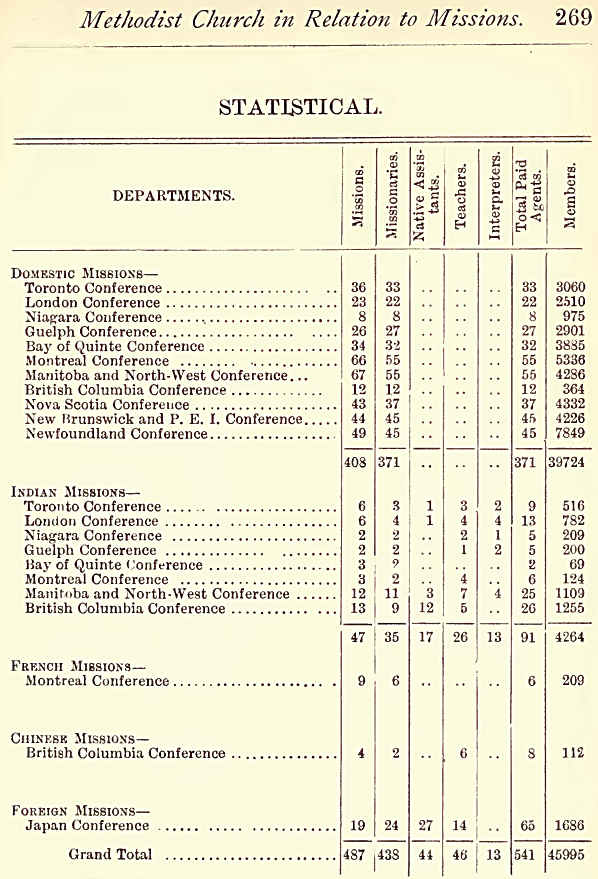
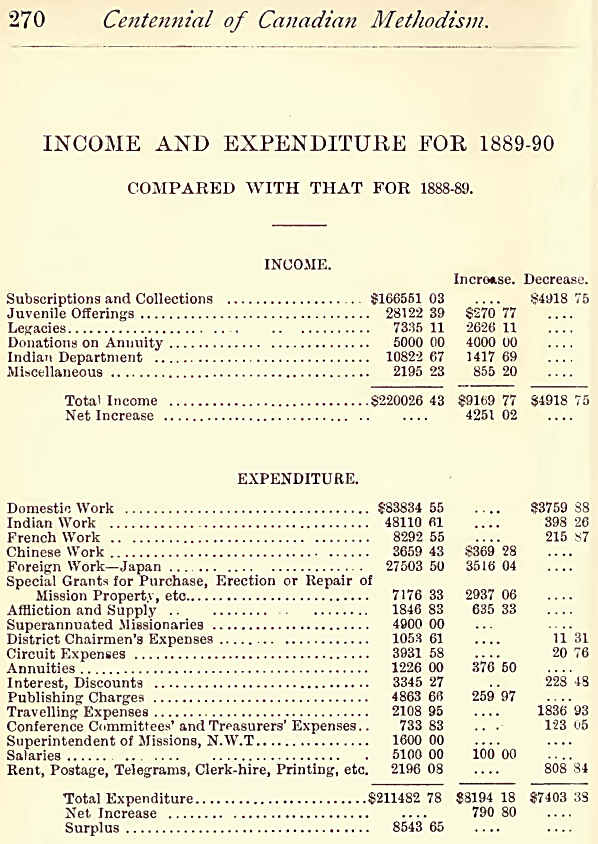
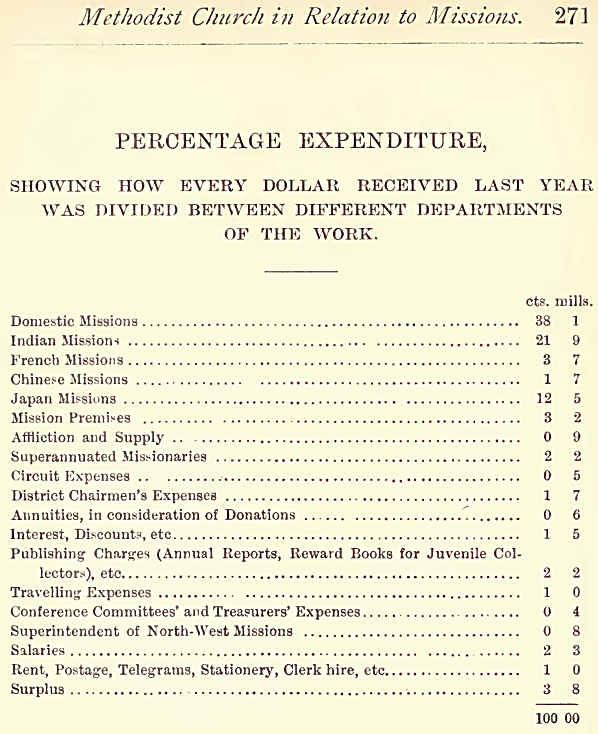
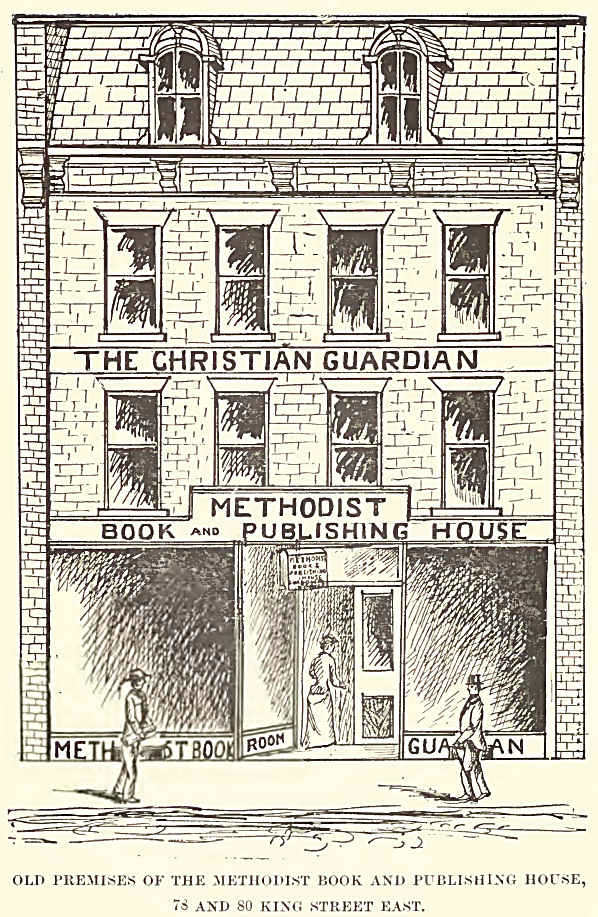
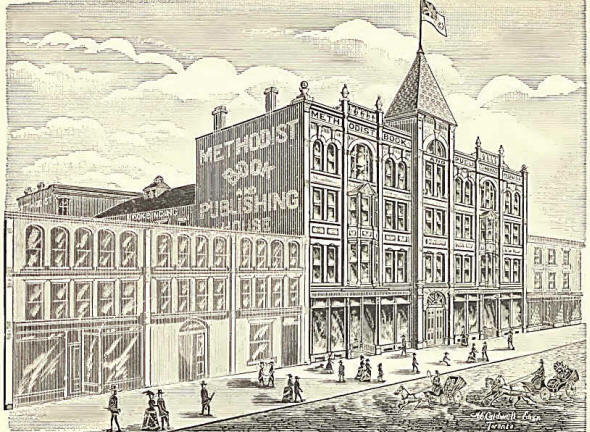 |
